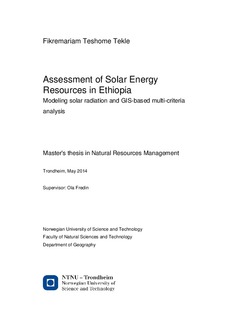| dc.description.abstract | The sun is an ultimate source of energy for life on earth, and hence the knowledge of solar radiation is essential for hydrological, climatological, biological modeling and utilization of renewable energy resources. Solar radiation can be measured from ground instruments at meteorological stations. Installations of instruments that directly measure global solar radiation are quite expensive, and thus spatial density of instruments is low. For instance, in Ethiopia there is only one Pyranometer, which is currently not functional. In addition, unlike rainfall and temperature, solar radiation cannot be interpolated for other areas with any degree of confidence from few sample measurements. This is mainly because the solar intensity is highly dependent on topography and surface features. Digital Elevation Models (DEMs) are important to derive these topographic characteristics that affect the amount of incoming solar radiation. Estimation of solar resources in a complex topography and inaccessible areas, where measurements are not available and/ or costly to measure over large areas from DEM is fast, cost effective and reliable. Ethiopia is located in the tropics and thus highly endowed with an abundance of solar energy. However, exploitation of solar energy is much underutilized and the energy sector is the least developed. The aim of this study is to calculate available solar energy resources and mapping the most suitable sites for large-scale PV installations in Ethiopia. The monthly and annual global solar radiations of Ethiopia were calculated from 30 meter resolution ASTER DEM using the ArcGIS solar radiation analysis tools. Solar radiation potential of Ethiopia ranges from 0.2 MWh/m2 /year in the lowlands (peripheral area) to 2.6 MWh/m2 /year in the central highlands. Large portion of Ethiopia receive solar radiation exceeding 1.8 MWh/m2 /year. Using GIS-based multi-criteria analysis, about 195 sites mainly in the eastern part of the country or 6000 km2 in total, were selected as ideal locations for large-scale PV installations in Ethiopia. The selection process takes various topographic, economic, social and environmental factors into consideration. Selected sites could, if exploited properly, generate more than 65 GW, which is about 1/6 of electric power of all nuclear power plants in the world assuming 10 percent PV efficiency. Finally, a sensitivity analysis was performed to verify the selected sites. It is hoped that this study will promote investments in solar energy and encourage researchers for further studies in Ethiopia. | nb_NO |
